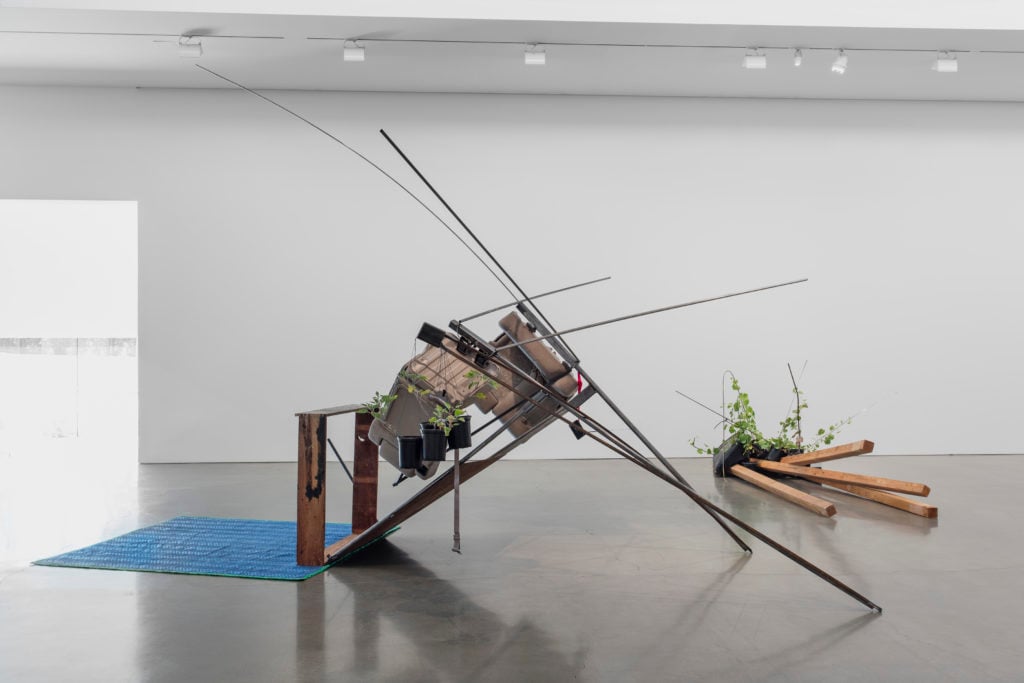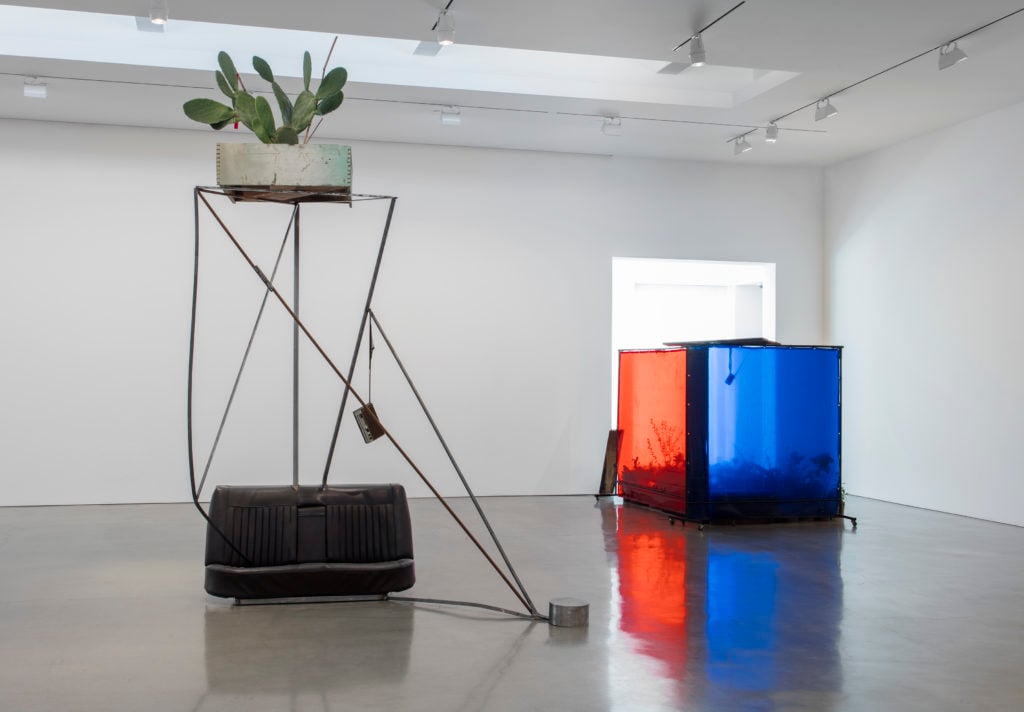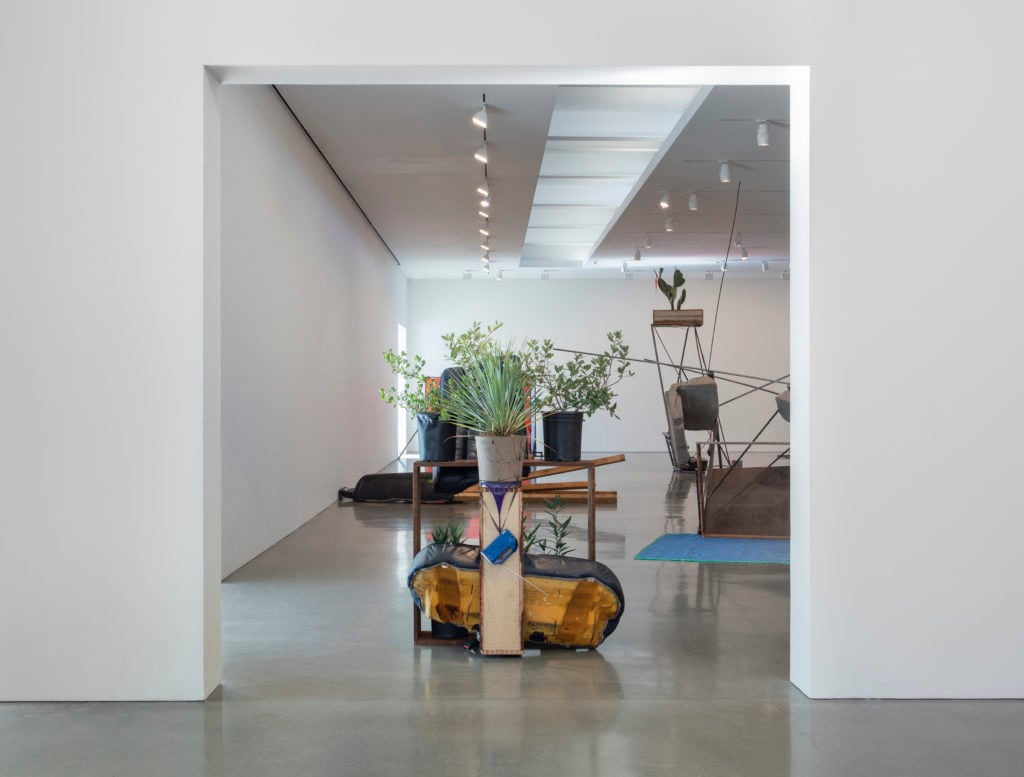On View
Abraham Cruzvillegas Challenges Los Angeles’s Culture of Trash at Regen Projects
The artist takes on the city's culture of cars and garbage.

The artist takes on the city's culture of cars and garbage.

Maxwell Williams

Anyone who’s ever owned an iPhone knows that its operating system updates will overwhelm it eventually. If you (and not everyone does) want to keep up with Apple’s latest software, you’ll have to upgrade your phone within about four years. This idea—planned obsolescence—isn’t new. The concept has been around since the 1920s, when mass production was first kicking into gear. But today’s technology companies have perfected it.
Abraham Cruzvillegas’s new show at Regen Projects in Los Angeles might be described as a look at the opposite side of planned obsolescence. Cruzvillegas invokes a period of time, when he was a young man growing up outside of Mexico City, in which such throwaway culture wasn’t as widespread as it is today. The automobiles from the 1960s were built to last a lifetime, as were the radios that transmitted important news to gathered families: residents of 1970s Mexico City, like Cruzvillegas, stayed glued to their radios for developments in the Guerra Sucia, or Dirty War—when the government cracked down harshly on student protesters.
If a radio or car were to break down, there wasn’t the option to “just get a new one,” as is so common today. Cruzvillegas’s family would take the machine—and they were more machines than the complex, electronic devices of today—to a technician. And if it broke again, they would take it to the repairman again, and again, until it had been exhausted beyond use. This was the situation that played out generally all over the world.
How does this translate to sculpture? As in every city where he produces work, Cruzvillegas has now shown up in Los Angeles empty-handed. The same happened at the Artsonje Center in Seoul last year, when he gleaned his material from the streets—in particular areas where residents have left to make way for new construction projects—and created a giant spiral jetty of unwanted objects in the gallery. Cruzvillegas has written about his intention to return life back to the discarded material.

Installation view of Abraham Cruzvillegas, “Autoconcanción,” Regen Projects, Los Angeles. Courtesy of Regen Projects.
In Los Angeles, of course, cars are the subject of this exploration. These works begin and end with discarded backseats, inspired by the automobiles Cruzvillegas’s parents owned. Then, using a system he has previously termed Autoconstrucción, he intuitively ad-libs the pieces together. They are wiry, precarious works, giving the impression of instability, as if they might topple over if you blew on them (or, God forbid, if an earthquake struck in the next month).
Cruzvillegas is an admirer of the mid-20th century Catalan sculptor Julio González, a mentor of Picasso’s, who would make autogenous works, dropping iron pieces onto his studio floor and welding them together in the form that they fell in. Cruzvillegas’s pieces are antecedent to this, with the added levity of the backseat, and the youthful comfort—and innuendo—that comes with it. (Cruzvillegas punctuates his point by hanging portable radios by women’s underwear from the sculptures.)
Cruzvillegas also sourced, from the Theodore Payne Foundation, a non-profit nursery for California-native plants. Each sculpture has at least one functional plant, meaning the plant is either edible or used in medicine.
But the work revolves around the backseat. In fact, he has written a poem titled “The Back Seat” about a mechanic who perpetually fixes his family’s ’69 Ford Galaxie, and the lovemaking that ensues in the backseat when the vehicle is finally roadworthy.

Installation view of Abraham Cruzvillegas, “Autoconcanción,” Regen Projects, Los Angeles. Courtesy of Regen Projects.
It’s tempting to say that there is wistfulness in Cruzvillegas’s work. On the contrary, repairing items was a matter of necessity. It is a privilege that we are now able to so easily replace an item if it breaks. But at what cost? Each iPhone, for instance, contains eight rare earth elements, which are ecologically disastrous to mine. At a volume of 232 million phones sold in 2015, the mounting danger is obvious.
It’s easy to get these ideas across. Many of us agree that consumerism and the trend towards more disposable objects is bad not only for the environment, but for our broader culture. Even Pope Francis recently railed against throwaway culture.
But to sustain these ideas is another story. There is a value in consumption in our society, whether it’s as simplistic as impressing a potential mate with a shiny new object, or trying to make yourself feel happy by spending money. This is, of course, the fallacy of planned obsolescence: that we can be happy with more. Sometimes, Cruzvillegas seems to argue, we need nothing more than the backseat of a car—with a lover, perhaps—to achieve contentedness.
“Autoconcanción” is on view at Regen Projects, 6750 Santa Monica Boulevard, Los Angeles, September 17–October 22, 2016.